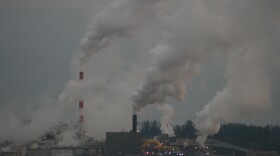Current State takes a tour of Fenner Nature Center's recent restoration of 19 acres of prairie land right in the middle of Lansing with the organization's executive director, Liz Roxberry.
When you think of the prairie, your mind probably travels a little farther west than Michigan...maybe to Nebraska or Wyoming. But before European colonization, Michigan had its fair share of the wide open range. Only around one percent of that habitat still exists today. Conservationists across the state are working to bring back some of those lost prairies, though.
In 2013, Lansing’s Fenner Nature Center set out to restore 19 acres of grassland habitat.
Current State’s April Van Buren took a tour of the recently completed project with Fenner’s Executive Director Liz Roxberry.
INTERVIEW HIGHLIGHTS
What an urban prairie looks like
Prairies are actually very dynamic ecosystems and there's a lot going on. So when we look at the shortgrass prairie, you know we’re in a unique environment being in an urban setting here in the heart of Lansing. Would you normally see those great big South Dakota type rolling hundreds of thousands of acres of landscape here anyway? No you wouldn't. So the primary purpose of this project was to really give a demonstrative plot that we could do some educational programming and educate the public about the diversity of prairie, the importance of pollinators. But then also have an opportunity to really restore what was a kind of sod bound, non-usable, invaded area for wildlife. So we've had two major goals and we've been able to meet them both.
On Michigan not being thought of as a prairie state
That’s one of the myths that we’re kind of working in the public to debunk. This is actually very typical for pre-settlement era. We had a lot of rolling topography that had great soil, sandy types that would really support these native grasses that are in this region. So yeah, up north you absolutely would see those great big conifer forests. Moving through the midline, you’d have more of the hardwood types. But down here, we absolutely had some of these native prairies.
The critters you’ll find at the restored prairie
Certainly pollinators, any of our insects that are kind of jumping around through these different pollinator plants. You can see the butterflies that happen out here. We have a lot of butterfly weed that's very attractive to them, monarchs on the milkweed. But there's also a lot of mammal activity. We have a great deer population. Deer will come out here to breed and bed. They’ll raise their young out here. And our turkeys are in love with this prairie. They can navigate really well. If you notice kind of the average height at this point is above the your waist line. So when you think about ground dwelling and ground nesting birds like turkeys…If they were trying to escape predation, they're going to have a much better shot getting through these tall grasses and being able to find some cover.





